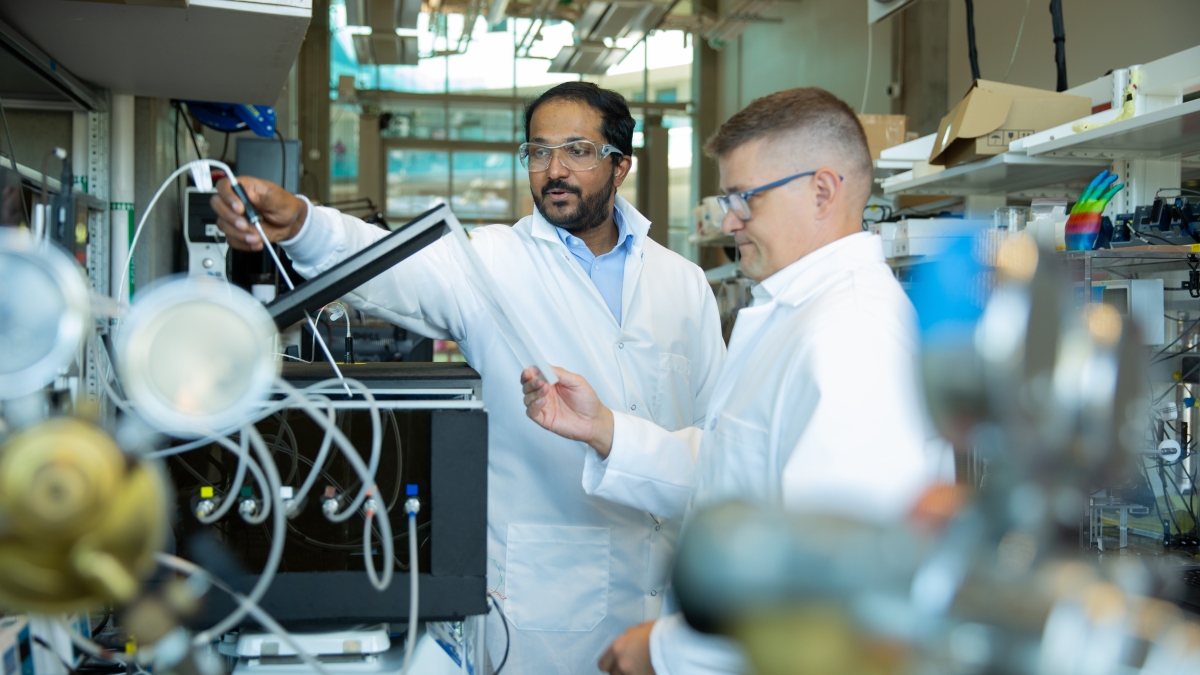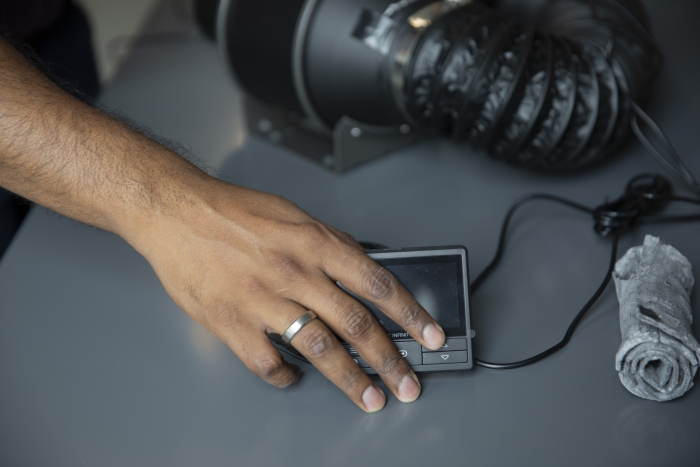ASU researchers develop new tech to help mitigate carbon emissions

Mani Modayil Korah (left), a Science and Technology Center postdoctoral fellow, and Matthew Green (right), an associate professor of chemical engineering and director of the Center for Negative Carbon Emissions in the School for Engineering of Matter, Transport and Energy, part of the Ira A. Fulton Schools of Engineering at Arizona State University, conduct research in the Julie Ann Wrigley Global Futures Laboratory. Korah and Green received support from the U.S. Department of Energy to develop innovative carbon capture technology to mitigate climate change. Photo by Roger Ndayisaba/ASU
From the ever-rising temperatures in Arizona to destructive flooding in many other parts of the world, the increase of carbon dioxide, or CO2, in the atmosphere has led to one of the biggest existential threats to humanity: climate change. CO2 is a greenhouse gas that lets sunlight through but prevents it from bouncing back into space. There have been more than 1.5 trillion tons of CO2 emitted since 1751.
“The emission of this invisible gas that you can’t see and smell for a long time had no effects on anybody, but now it’s hitting close to home through wildfires, once-in-a-century flooding events and more,” says Matthew Green, an associate professor of chemical engineering in the School for Engineering of Matter, Transport and Energy, part of the Ira A. Fulton Schools of Engineering at Arizona State University.
Green, director of ASU’s Center for Negative Carbon Emissions, adds, “I have a graduate student in my group whose family was displaced twice in his home country of Nigeria because of flooding. To him this issue is personal.”
Green and Mani Modayil Korah, a Science and Technology Center postdoctoral fellow in the Fulton Schools, are developing a novel technology to remove CO2 directly from the atmosphere. They were recently named semifinalists in the competition for the Direct Air Capture Pre-Commercial Technology Prize given by the U.S. Department of Energy. Their team won $100,000 in cash and $50,000 in technical assistance to support their research commercialization efforts.
“We were one of the seven teams selected out of 93 applicants, and we are excited to receive the award because it brought a lot of traction to our research,” Korah says.
“This award validates the efficiency and scalability of our approach,” Green says. “It could be one of the solutions that helps save the planet.”
Green and Korah are working to address an issue affecting millions of people across the globe. In 2015, 195 nations met in Paris and pledged to limit the increase in global average surface temperature to 1.5 degrees Celsius above the pre-industrial levels by using various scientific strategies.
Nonetheless, 2023 was the warmest year in recorded history, and approaches to curbing rising temperatures aren’t as effective as they need to be.
“It also doesn’t help that people are not switching to clean energy sources quickly enough,” Korah says.
“We have waited for far too long to take necessary actions to limit temperature rises to 1.5 C,” Green says. “The job is much harder.”
According to the Intergovernmental Panel on Climate Change, if, or when, global warming exceeds 1.5 C above the pre-industrial levels, the effects of climate change on human and nature systems, including biodiversity and ecosystems, will be substantially worse.
“Capturing the CO2 that humans have released throughout the course of history would go a long way to actually reducing or even reversing the effects of climate change,” Korah says.
Cleaning the sky
There are various ways to decarbonize the atmosphere, and direct air capture, or DAC, is one of the most effective.
DAC is a technology that removes CO2 directly from the atmosphere. It typically consists of an air contactor that exposes a sorbent material to the air, selectively capturing CO2, and a regeneration system to remove CO2 captured by the sorbent material in a controlled way. The captured CO2 can be stored deep underground or upcycled to low-carbon-footprint, value-added products.
While effective, most DAC technologies are difficult to deploy at a large scale.
“The first industrial process to isolate and purify CO2 was discovered over 100 years ago,” Green says. “We know how to capture CO2 from the atmosphere, and we understand the effect of the ever-rising CO2 concentrations on average global temperatures. So, simply put, there’s just been a resistance to do anything because DAC systems were expensive and not profitable.”
Korah adds, “Most people use polymer materials as sorbents, which have to be changed about every six months because they degrade easily. This makes the technology expensive and inefficient.”
Korah and Green’s DAC technology is designed to be cost-effective, scalable and environmentally friendly by using sorbents from inorganic salts similar to baking soda. By utilizing readily available and stable materials such as potassium bicarbonate and activated carbon, they are able to reuse their sorbents over a long period of time.
Unique microstructures in their material allow their sorbent to capture more CO2 from air at a low cost. To them, this is a groundbreaking discovery in the realm of curbing climate change through decarbonization.
“We see making sorbents from cheap materials as one of the best ways to ensure that carbon capture technologies are commercially viable, therefore making them a more appealing solution for climate change,” Korah says.
While Korah and Green understand how to create a more efficient DAC technology, they still have various hurdles to overcome to commercialize their solution. One of the biggest challenges is that the regeneration part of their technology, in which the CO2 is retrieved from the sorbent, requires a lot of energy that can be expensive when deployed at a large scale.
The team hopes to significantly reduce this energy requirement and utilize solar and wind energy resources available in Arizona to sustainably power their DAC process.
“Similar to windmills, we want to see this technology everywhere working every day to save our planet, and achieving this goal requires that the grid be green,” Korah says. “People in different disciplines should come together and try to solve this issue from different angles — that’s the only way we can solve it at scale.”
Korah and Green intend to enter the market by serving prominent emitters of CO2, such as cement and aviation fuel producers.
“Using CO2 in their processes taken directly from the air would reduce their carbon footprint significantly,” Green says.
In the long term, they aim to deploy their technology globally, enabling countries, companies and individuals to offset their annual carbon emissions by capturing an equivalent amount of atmospheric CO2.
Korah and Green will participate in the design and deliver phases of the Direct Air Capture Pre-Commercial Technology Prize in which they will get their technology ready for implementation through their startup, NuAria, and compete for a grand prize of $1 million. Green says he has no doubt that their technology will be one of the top picks due to resources available at ASU.
“Our team is comprised of engineers, physicists, biologists, chemists and people with business backgrounds. With their help, we can tackle what seems like an insurmountable challenge,” Green says. “I think ASU is really one of the few places in the world where this type of collaboration is possible.”
More Science and technology

ASU student researchers get early, hands-on experience in engineering research
Using computer science to aid endangered species reintroduction, enhance software engineering education and improve semiconductor material performance are just some of the ways Arizona State…

ASU professor honored with prestigious award for being a cybersecurity trailblazer
At first, he thought it was a drill.On Sept. 11, 2001, Gail-Joon Ahn sat in a conference room in Fort Meade, Maryland. The cybersecurity researcher was part of a group that had been invited…

Training stellar students to secure semiconductors
In the wetlands of King’s Bay, Georgia, the sail of a nuclear-powered Trident II Submarine laden with sophisticated computer equipment juts out of the marshy waters. In a medical center, a cardiac…
